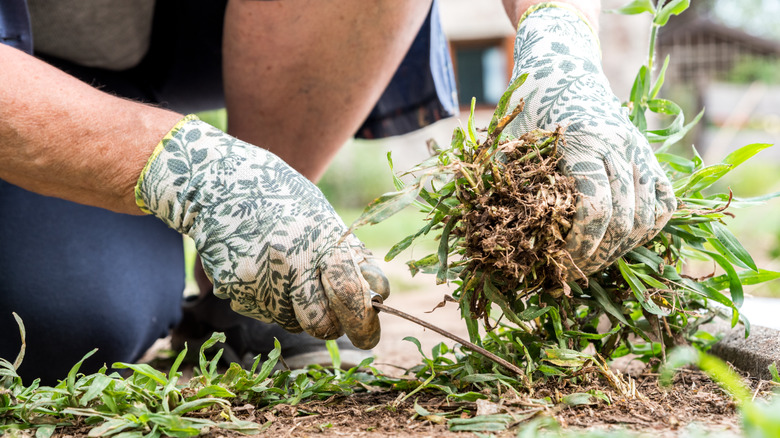Get Rid Of Weeds On Your Patio With A Natural Liquid You Already Own
If you're dealing with the nuisance of weeds on your patio, you might be surprised to learn that a solution could lie in a common household product: hydrogen peroxide. This might sound unconventional, but a 2021 study published in the Naresuan University Journals lends credence to this claim, as they discovered that 10% hydrogen peroxide can successfully get rid of various weeds. Interestingly, the study also highlighted that the concoction was mixed with 0.2% dish soap. They also tried another combination of 10% hydrogen peroxide mixed with 0.2% soapberry extract, and this formula was successful in suppressing sleepy grass but not other grassy weeds.
Despite these positive results, it's important to note that there's no concrete evidence supporting the use of 10% hydrogen peroxide alone to get rid of weeds, as the addition of dish soap seems to enhance the formula's effectiveness. It's unclear why this is, but it's probably due to its properties as a surfactant. While this doesn't fully establish hydrogen peroxide's reliability as a standalone weed killer, it does suggest its potential usefulness, especially when combined with other methods of weed elimination. Moreover, understanding the nature of the weeds you're dealing with is crucial for successful eradication. You should also ensure that you wear gloves, a mask, and goggles while using concentrated hydrogen peroxide as it can cause skin, eye, and respiratory irritation, per the CDC.
Tackling weeds with hydrogen peroxide: understanding patio weeds
In your battle against patio weeds, knowledge is as crucial as the tools you use. When tackling weeds whether using hydrogen peroxide or another method, it helps to understand the nature of these plants. They are resilient and can thrive in challenging conditions, often outcompeting the plants you want to grow. Their varied types require different approaches for effective control, so start by identifying the types of weeds you're dealing with. This helps in determining how best to apply the hydrogen peroxide solution for maximum effectiveness. Some common garden weeds include dandelions, crabgrass, and clover, and each has unique characteristics and growth patterns. For instance, dandelions have deep taproots, making them challenging to eliminate, so they may require multiple applications to fully die.
Once you've identified the weeds, put on your gloves, mask, and goggles and prepare your hydrogen peroxide weapon. The 10% solution (not 3%, or what you normally find in stores) mixed with dish soap was the more effective formula. Because this solution hasn't been highly-tested, it's best to be cautious during the application and test a small area first. This solution may harm desirable plants, so aim carefully to avoid collateral damage. If you're dealing with a variety of weeds, consider spot treatment to target each weed without affecting the surrounding area. All in all, persistence is key. Some weeds might require several treatments before they're completely eradicated, so regularly check your patio and reapply the solution as needed.
Effective post-treatment strategies: weed pulling and disposal techniques
After treating your patio weeds with hydrogen peroxide and allowing the mixture to kill them, the next step often involves manual removal while wearing gloves. Pulling weeds might seem straightforward, but you need to use the right techniques to enhance your efficiency and reduce the likelihood of regrowth. Firstly, timing is crucial for ease of removal. Aim to pull weeds after a rainfall or watering session, as moist soil allows for easier extraction of the entire root system which is vital to prevent the weed from growing back. For tougher weeds, use tools like a weed puller or a small trowel to loosen the soil around the root, facilitating complete removal.
When pulling weeds, try to get as much of the root out as possible. This is especially important for weeds with long taproots like dandelions. However, this might require a bit more digging and patience. Disposal of the removed weeds is another critical aspect. Do not leave them on your patio or in your garden, as they might reroot or spread seeds. Interestingly, some weeds, like creeping buttercups (without the flowers), are great for composting after they've been dried out. If the weeds haven't gone to seed, you can add them to your compost pile. However, if they have seed heads or are particularly invasive, dispose of them through your municipal green waste service or in your trash to prevent spreading.


